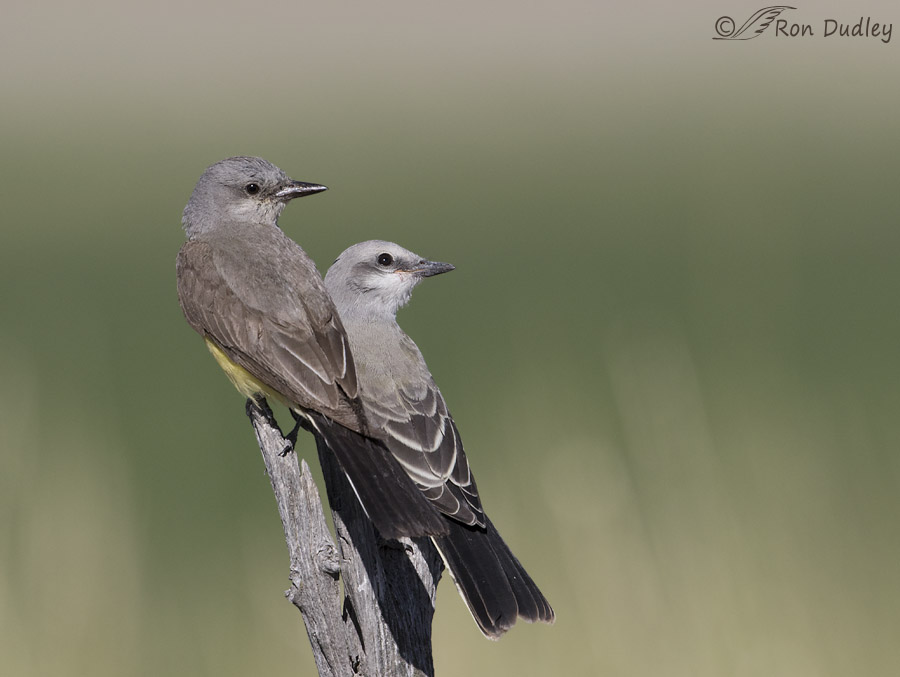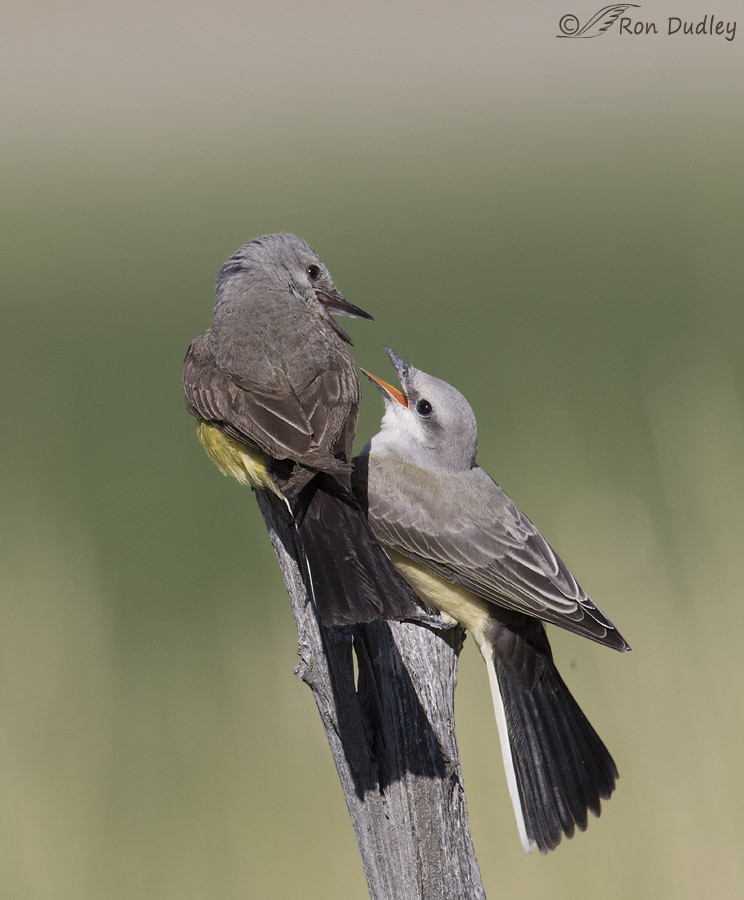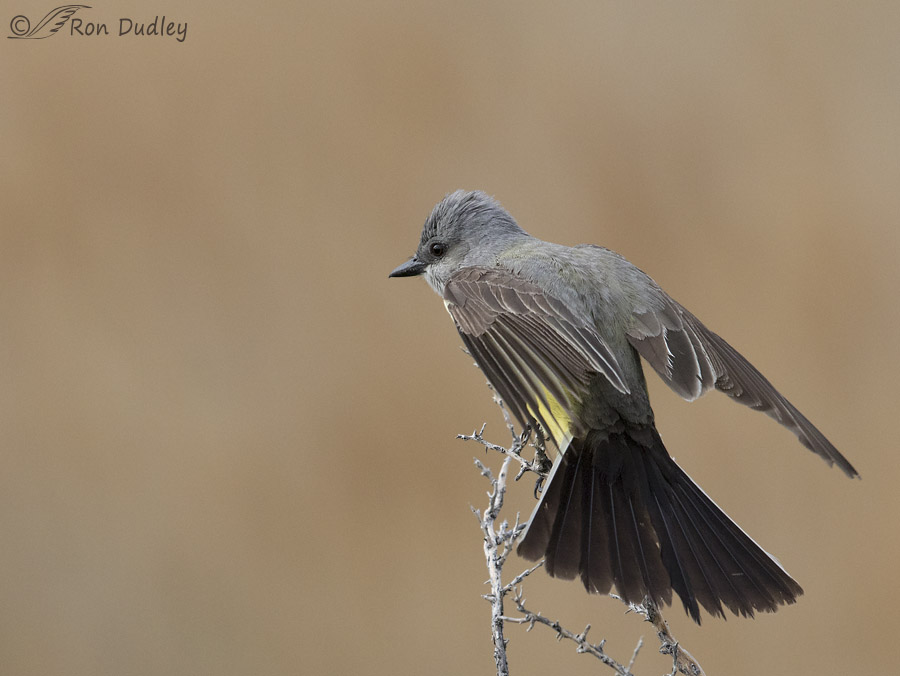Sometimes what I see in the field and in my images doesn’t match very well with what I see in field guides. This is an example.

1/2000, f/9, ISO 640, Canon 7D Mark II, Canon EF500mm f/4L IS II USM +1.4 tc, not baited, set up or called in
Nine days ago I photographed two juvenile Western Kingbirds as they begged for food from one of their parents near Howell, Utah. Here we see the adult on the left and one of the juveniles on the right. Note that the light on the birds and their poses are essentially identical. To my eye the difference in dorsal body and head colors of the two birds is fairly dramatic.

1/2000, f/9, ISO 640, Canon 7D Mark II, Canon EF500mm f/4L IS II USM +1.4 tc, not baited, set up or called in
Another shot of the same two birds shows the same thing and if I remember correctly the other juvenile looked just like this one.
But the color plates of the Sibley Guide to Birds (both the newer 2nd edition and the older version) show the dorsal colors of adult and juvenile to be virtually identical and that confuses me. It makes me wonder who got it wrong – these birds or Sibley…:)
I realize that there are color variations in birds (and that both David Sibley and I make mistakes – some of his mistakes have been corrected and mine often are…) but to me this seems a little extreme to be accurate. I’d be interested if those of you who have a copy of Sibley could take a look and let me know if you agree. Or not. I have a lot of respect for David Sibley and his work but in this case I’m having trouble reconciling my images with his paintings (there are sites on the web that include Sibley’s paintings and I’d like to provide links to them for those who don’t have a copy of the field guide but they seem to be copyright infringed so I won’t be doing so).
Could this simply be a matter of regional variations (which doesn’t make much sense to me because these birds are migratory) or molt timing? Or possibly a lack of accurate color interpretation on my part? (I color-calibrated my monitor just yesterday.) Or am I making a mountain out of a mole hill?
Ron
PS – I’m only a bird photographer and not a birder with great ID skills so I’m just trying to learn something here.
Addendum: I’m posting the following image in response to the question posed by Daniel Gustafsson in his comment below. The image was taken on May 25 of this year.



Thanks to Ron for posting some great photos and starting this discussion, and to Dick for alerting me to it. There is certainly a very clear difference between these two birds, and I did not do a very good job of capturing those differences in the guide. I wasn’t trying to show the difference between a very worn adult and a fresh juvenile, but still, there are things that could be improved.
A lot of the difference in these two individuals in the photo is simply the age of the feathers, as others have already pointed out – brand new on the juvenile and almost a year old on the adult. In general among songbirds it is very easy to determine age this time of year, because the feather condition of adults and juveniles is so different. By November when the adult has molted to new feathers it will look a lot “cleaner” and more like the juvenile. It is also likely that juveniles are variable, with some very pale and others closer to adults.
Deciding what to show in the guide is always a balancing act. I usually opt for the “average” rather than the extreme, and try to avoid showing rare variants or differences that are only visible some of the time (unless these involve real ID pitfalls, and in that case I illustrate the typical bird as well as the variant). Because the illustrations contain so much more information than could ever be in the text, it is unavoidable that readers will search the images for details, and even the slightest (sometimes unintentional) difference between illustrations might be picked out as a potential field mark. In the case of the Western Kingbird illustrations, I opted to make the adult and juvenile very similar, because they are really hard to tell apart except when you see a worn adult with a fledgling (as in Ron’s photos), and I was also concerned about how they would compare with Cassin’s Kingbird and other species.
Nevertheless, I have some ideas now about how to represent these ages better in future revisions of the guide. It might involve adding a third perched illustration to show three ages: juvenile, fresh-plumaged adult, and worn adult. But that might require doing the same for all of the kingbirds…
Thanks, again, for bringing this up; learning is what this hobby is all about.
I bought the first print of the second edition of Sibley’s at an Audubon talk that David Allen Sibley did. He spoke a bit about why he paints birds that vary a bit from what one would typically see in the field. He spoke about why he showed so much white on the juveline Red Crossbill wing. He said he chose to paint this unusual variant because it is most easily confused with the White Winged Crossbill. He does take some artistic license without always explaining why in the text. I am struck by the green wash in his paintings which is absent in the photo. It will be interesting to see what he says.
In the photos, the spring adult still looks a bit darker to me. I could be sun angle.
Colors seem the same in Sibley’e Eastern Bird book
After reading Daniel’s explanation I looked at the May pictures, and I agree that the adult is a lighter color than in the current pictures. But it is still not as light in color as the juvenile in this post.
I agree, Susan.
The juvenile may have feathers that are only weeks old and have never been used to fly any long distances, whereas the spring adult may have feathers that are still a few months old and have been used to fly from wherever they winter to Utah. So the discrepancy between the photos and Sibley may be because of this even in this case. It may also be that the birds in Utah are particularly dark, and that Sibley’s bird is from a lighter population. Tricky when you’re only comparing single birds, and the bird guide bird is of course supposed to represent the entire population, and therefore the individual illustrated doesn’t exist.
This is precisely why even the worst guide with paintings is better than the best guide with photos: photos illustrate a single individual, whereas illustrations (theoretically) illustrate all individuals (and thus none).
Well said, Daniel – particularly your last sentence.
Nothing of any use to add to the discussion.
Thank you – and those who have the knowledge/experience to comment.
The differences did indeed seem marked to me.
I wonder how much discoloration the sun causes on these birds. Fascinating post, Ron.
Good question, Arwen. I know that some birds do become sun-bleached or faded.
I see the same difference as you, however it seems to me that while the juvenile has fresh feathers (which makes sense), the adult has very worn feathers. This is more obvious in the tail feathers of both pictures than in the wing feathers, but the pale edges of the secondaries in the adult are virtually gone, but more pronounced in Sibley’s guide. I have no book at hand to tell me what moulting strategy these birds use, but Sibley’s comment that “white tail edges may disappear when worn (Aug-Oct)” suggests to me that the adults will not moult until after migration. If this is the case, I would assume that Sibley’s illustration of the adult is of a fresh individual in spring, whereas the adult in your photo is very worn. This could account for much of the colour difference, as wear would affect also contour feathers. Do you have any photos of adults just after they’ve arrived here in similar light to compare with?
(The biggest problem with the Sibley guide is the enormous waste of space for no good reason… how can the Collins guide in Europe treat about as many species, have more illustrations, more text, better descriptions, more subspecies illustrated, more and better sound descriptions, and yet by significantly smaller and lighter???)
Thanks, Daniel. I’ve never been good at evaluating the effects of wear on feathers so I appreciate your input.
I’m unfamiliar with the Collins guide.
In response to your question I’ve posted an image above of an adult Western Kingbird taken on May 25 of this year. What do you (or others) think?
To me, the spring bird looks more similar to the first juvenile in back colour, though the spring bird is also worn (look at the frayed tail, for instance), so it’s hard to tell. I have no idea what the moulting pattern of these birds are, but would guess, judging from these pictures, that the spring bird moulted at least partially before it migrated north, but won’t moult very much while it is up here. The spring plumage looks fresher than the autumn plumage when comparing the adults, but you can see that some of the secondaries and some of the coverts of the spring bird have been moulted more recently than the others (they are greyer in base colour and the white edges are much clearer).
(Incidentally, the difference in base colour on these feathers should answer Arwen’s question: yes, feathers do get sun-bleached, which is one of the reasons, together with wear, that these have different colours.)
So yeah, I think the difference is in moult. Here’s my guess:
1. Adults moult at least partially at wintering grounds. The spring adult has moulted the innermost secondaries and some coverts on both wings, which is why they are greyer and with more clear white edges than the other, unmoulted, feathers. I feel rather confident that this is done at wintering grounds because even these are slightly worn, and anyway that is what usually happens. Whether the moult is interrupted or arrested is probably not possible to tell from these photos, and you’d need to study a long series of birds over a summer (1).
2. Adults do not moult on breeding grounds, or at least not until much later than August. I base this on the very worn condition of the autumn adult, and the fact that Sibley states that birds are worn in North America between August and October.
3. The juvenile may or may not moult (some birds actually do moult already the first summer/autumn!), but I doubt we could figure this out without handling the birds.
4. Sibley’s illustration is of a spring adult, meaning that it is fresher than the autumn bird, and may look more similar to a juvenile. What he could have done would be to point out that these birds turn browner later in the season, but given that he generally gives so very little information about anything in his book, it’s not surprising that he left this out, and in any case this is information that is needed more often by bird banders than by birdwatchers, I guess.
—
(1) Arrested mount = moult is partial, so only some feathers are changed, but when moult starts again, the already moulted feathers are moulted again.
Interrupted moult = moult is partial, so only some feathers are changed, but when moult starts again, the already moulted feathers are not moulted.
Another way to see if the feathers are worn or not is to look at the shape. Compare the second and third feather from the body on the right side of the spring bird with the same feathers of the first picture. In the spring, these recently moulted feathers are much more rounded, whereas in autumn they are narrower and pointed.
Very interesting information, Daniel. I’ll have to read it all several more times to fully digest it but this should certainly help me understand molts and plumages better. Thank you very much!
No worries. Just remember that these things are often different between different families (or even genera or even species!) of birds, so it’s hard to predict. Some bird moult both before and after migration, some moult only once, some moult different feathers at different times, and so on. Still, it helps a lot, especially when it comes to some bird groups like gulls.
Ron, just checked in my copy of Sibley, and I see what you see. Their is a difference in the dorsal coloration in your shots that doesn’t appear in the 1st Edition. I just bought this book from the Nat Park store at Sabino Canyon, and just found out it’s from 2003, must be clearing out OLD stock!
I once questioned why “plates” were used in the Sibley guide on my iPhone and was quickly told there’s just too much variation in bird coloration to use photo’s. An impossible task I was told. 2 very knowledgeable birds here in Tucson that lived in Salt Lake for years.
I’m curious to see if Dick gets a reply?
Thanks for your wonderful shots, the first thing I look at every morning!
Alan
Thank you, Alan, As far as I can tell there’s no difference between the paintings in the older version and those in the first printing of the 2nd edition. My newer book is a signed copy so I want to keep it but I may have to buy one from a more recent printing so I can actually read it.
I just checked my Sibley guide (first edition) and the only difference I see in those paintings between adult and juvenile is that the juvenile has a lighter shade of yellow on the belly (which does show up in your second shot). I don’t think you are seeing wrong with the juveniles being lighter. 🙂
Thanks, Susan. Yes, the paintings show that difference in the ventral yellows and these birds demonstrated that same difference.
Thereis something touching and unusually graceful about both of these shots. The coloration differences are so dramatic, they almost look like different species. Indon’t have a Sibley book, always meant to get one…some seem to consider them as the “birder’ bible”…unless they are pathetically arrogant (which I doubt), I would think they’d be very interested in these shots and grateful to see them.
Patty, From what I’ve read David Sibley has always been receptive to constructive criticism of his work. Thanks for the feedback on the color differences.
Sensational shots Ron! I think you are correct. No one is infallible.
Charlotte
Thank you, Charlotte.
Excellent! Very dramatic between the grays of the juvenile and browns and dark feathers of the adult.
You are right about Sibley getting it wrong in this instance, even in the second printing of July 2014. That printing was to correct the red colors in some birds.
Your example shows the marked difference between the adult and the juvenile, even though the first picture shows the adult being less dark than the second picture. That being said as a general field guide to ALL the birds in the US along with rarities Sibley’s work is not bad.
I think you should send him these shots and ask him for his analysis/survey. He certainly would give you a better explanation.
Thanks for that feedback, Dick. It’s nice to know that someone else sees what I see.
In general I think Sibley’s work is excellent though I was very disappointed in the fine gray print in the first printing of the second edition. These old eyes can barely read that print so I still often go to my tattered first edition. I understand that’s been corrected in later printings.
I don’t feel very comfortable sending him these shots, partly because I suspect that others may have already mentioned this to him and partly because I don’t want to come across as being uppity – after all I’m not much of a birder and many others know their stuff much better than I do.
Well, I don’t know him personally, but I do have friends who do know him and I would be happy to be an intermediary. I think it would be educational as well as interesting to get his take on this.
Do whatever you think best, Dick. You’re much more of a birder than I am so coming from you (or your friends) it might have more impact…
OK, lets see what kind of comments we get. Thanks.
Ron, I see David Sibley has replied relative to the Great Horned Owls, but NOT the Western Kingbirds as yet. This must mean is has read and is reading your blog. Hope he answers about the Western Kingbird.